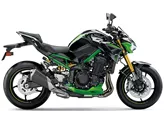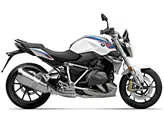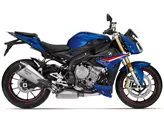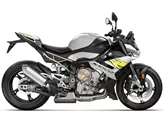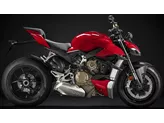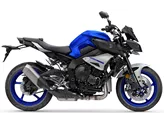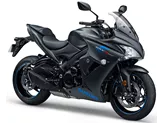BMW S 1000 R 2016 vs. Kawasaki Z1000 2014

BMW S 1000 R 2016

Kawasaki Z1000 2014
Pregled - BMW S 1000 R 2016 vs Kawasaki Z1000 2014
The BMW S 1000 R 2016 and the Kawasaki Z1000 2014 are both naked bikes with similar engine types, inline four-cylinder engines. However, there are several differences between the two models.
In terms of engine power, the BMW S 1000 R 2016 has a higher output with 160 HP compared to the Kawasaki Z1000 2014's 142 HP. The BMW also has a slightly higher torque of 112 Nm compared to the Kawasaki's 111 Nm. This means that the BMW offers more power and potentially better acceleration.
Both bikes have upside-down telescopic fork front suspensions and aluminum frames, which provide stability and good handling. However, the BMW has a Twin Tube frame type, while the Kawasaki has a Double Cradle frame type. This may result in slightly different handling characteristics, with the Kawasaki potentially offering a more comfortable ride.

BMW S 1000 R 2016
In terms of braking, both bikes have double disk front brakes with four pistons. However, the BMW's front brakes also feature radial technology, which can provide better braking performance. The Kawasaki's front brakes also have petal technology, which can improve heat dissipation and reduce brake fade.
Both bikes have the same tire dimensions, with a 120 mm width and 17-inch diameter for the front tire, and a 190 mm width and 17-inch diameter for the rear tire. This ensures good traction and stability on the road.
The wheelbase of both bikes is similar, with the BMW having a slightly longer wheelbase of 1439 mm compared to the Kawasaki's 1435 mm. The seat height is also similar, with the BMW at 814 mm and the Kawasaki at 815 mm. This means that both bikes offer a comfortable seating position for most riders.
In terms of fuel tank capacity, the BMW has a larger tank with a capacity of 17.5 liters, while the Kawasaki has a smaller tank with a capacity of 15 liters. This means that the BMW has a longer range before needing to refuel.

Kawasaki Z1000 2014
In terms of strengths, the BMW S 1000 R 2016 has a powerful and well-controllable engine, a powerful braking system, and a comfortable seating position. On the other hand, the Kawasaki Z1000 2014 has a sophisticated design, extremely pleasant handling, a pleasant sound, and good brakes.
In terms of weaknesses, the BMW S 1000 R 2016 has expensive optional extras that may be irresistible but can add to the overall cost of the bike. It also has a hard chassis, which may result in a slightly harsher ride. The Kawasaki Z1000 2014 has a higher purchase price compared to the BMW S1000R.
Overall, both bikes have their own strengths and weaknesses. The BMW S 1000 R 2016 offers more power and potentially better braking performance, while the Kawasaki Z1000 2014 has a sophisticated design and pleasant handling. The choice between the two would depend on individual preferences and priorities.
Tehničke specifikacije BMW S 1000 R 2016 u odnosu na Kawasaki Z1000 2014
Prednosti i nedostaci u odnosu na
Prednosti i nedostaci u odnosu na
BMW S 1000 R 2016

With the BMW S 1000 R, you notice both the close relationship to the S 1000 RR superbike and the endeavour to equip the machine with a high degree of comfort for country roads and everyday use. Accordingly, the 1000cc four-cylinder power unit is brute and yet easily controllable, and the seating position is correspondingly sporty and comfortable. The fact that the S 1000 R is one of the most affordable power naked bikes is surprising and very pleasing, although one must not get hold of the list of optional extras - because thanks to the many irresistible features, it will certainly be more expensive.
Kawasaki Z1000 2014

The Kawasaki Z1000 (2014) is a statement against the electronic trend of its time - and that is exactly what makes it special today. Its characterful four-cylinder engine, mechanical directness and uncompromising focus on the essentials strike a chord in a time when many bikes have become rolling computers. Yes, it does without modern Advanced Rider Assistance Systems and perfect wind protection. But it offers an authentic naked bike riding experience, paired with Japanese reliability and reasonable maintenance costs. The Z1000 is not a bike for data sheet junkies or electronics fans - it is a bike for people who still want to make their own decisions when rider. An honest bike with character that continues to inspire even after years and more than fulfils its role as an emotional alternative to the digital modern age.
Usporedba cijena Prosječna tržišna cijena BMW S 1000 R vs Kawasaki Z1000
There are a few key differences between a BMW S 1000 R 2016 and a Kawasaki Z1000 2014. In terms of price, the actual average price of a BMW S 1000 R 2016 is about 24% higher. A BMW S 1000 R 2016 experiences a loss of 380 USD in one year and 1,940 USD in two years of ownership. This is offset by a loss of 660 USD and 490 USD for a Kawasaki Z1000 2014. Compared to Kawasaki Z1000 2014 there are less BMW S 1000 R 2016 bikes available on the 1000PS.de Marketplace, specifically 10 compared to 12. It takes less time to sell a BMW S 1000 R with 69 days compared to 75 days for a Kawasaki Z1000. Since model year 2014 1000PS.de editors have written 62 reviews for the BMW S 1000 R and 41 reviews for the Kawasaki Z1000 since model year 2005. The first review for the BMW S 1000 R was published on 11/3/2013 and now has more than 17,300 views. This compares to more than 5,800 views for the first review on Kawasaki Z1000 published on 9/2/2002.




